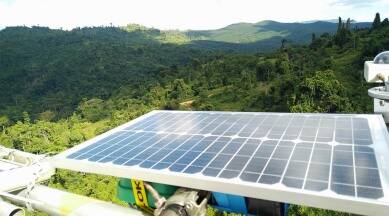Researchers have developed a new hands-off approach to monitoring biodiversity, where they use a network of recording devices to record a soundscape of a region. The SAFE (Stability of Altered Forest Ecosystems) Acoustics project uses these sound recorders and machine learning models to monitor for changes in this soundscape over time and get early warnings about the health of various ecosystems.
SAFE Acoustics enables researchers to monitor biodiversity at various locations with minimal human interaction. The technology itself is open-source, and the researchers provide a step-by-step guide to building sound recording devices from scratch using a Raspberry Pi and other components. Alternatively, you can buy a “Bugg” recording device developed by the researchers for the same purpose.
These recorders can record high-resolution audio 24/7, compress them and upload them using solar panels and a battery. After this, cloud-based advanced machine learning algorithms process the sound automatically. The approach begins with the creation of sound reference points, measuring the biodiversity on the ground at the site in question. This is known as “ground-truthing.”
“When we’re trying new technologies for biodiversity monitoring (especially when employing machine learning models), we want to ensure that the results we get are reliable, and line up with previous approaches to monitoring. We normally use “point counts” to ground truth our data, where experienced researchers stand at a fixed point for around 20 minutes and write down every species they see or hear,” Sarab Sethi, who leads the project, told indianexpress.com over email. This data can then be used to train machine learning models to identify changes in the population of different species. Sethi is currently a Herchel Smith Research Fellow at the University of Cambridge.
“The devices were built to withstand long deployments, data is remotely transmitted, and power comes from solar panels. These devices can therefore be permanently deployed, with maintenance only needed rarely. Based on past deployments, this is normally every 6 months, like when an animal disturbs the set-up, but we are always working to make the recorders more reliable and hope to get to deployments of 1-2 years without maintenance,” he added.
The idea with SAFE acoustics is not to replace the need for researchers to go to field sites and record data from there, but to direct limited human resources. Networks of sound records can help gather coarse-level information from a large area. The system can then tell researchers which locations are most at risk, so precious time isn’t spent on surveys in places with no biodiversity change.
“Our recordings have everything from ants, flies, birds, frogs, cicadas, elephants, gibbons, humans, etc. Many species contribute to the soundscape, making it such a rich source of information,” said Sethi.
According to the University of Cambridge, researchers in Norway are using the recorders to monitor the arrival and breeding patterns of migratory birds. Recorders can monitor locations where the bird would have otherwise been missed by researchers who cannot continuously stay on the field. This makes it easier to pick up climate change-driven migration variations.
In Borneo, the recorders are used to monitor areas in various stages of landscape degradation, from old-growth forests to logged forests, to oil palm plantations. Interestingly, recorders are also being used in the Arctic circle to record the noises of agitated ants, which can help detect environmental pollution.
Sarab Sethi led the SAFE Project with supervision from Rob Ewers, Nick Jones and Lorenzo Picinali from Imperial College London. He also worked with David Orme, another researcher at Imperial College London, to develop the technology.
Source: indianexpress.com









